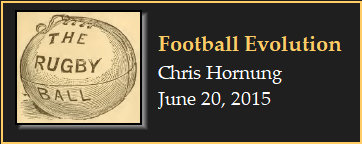






Questions or comments? Please email me at:

July 2021
1867 Alden Patent
"Covering for Foot Balls"

On February 24, 1839, Charles Goodyear was issued a patent for a process of vulcanizing India-rubber which enabled it sustain higher temperatures and thus be more widely used in products such as shoes, hoses, and tires. It took decades for Goodyear to further perfect his process, through the addition of lead and sulfur, before rubber products became ubiquitous in American society. The technology to create thin, durable and inflatable rubber membranes wouldn't existing until the 1870's. Prior to this. inflatable sports balls, such as footballs, were typically made of an animal bladder core wrapped within a leather or fabric casing. The bladder would be inflated using a straw or similar flexible tube and then tied close to retain air. These balls were susceptible to bursting, were distasteful to inflate, and had limited longevity as the casing would become waterlogged and crack.
On December 31, 1867, Henry A. Alden received U.S. Patent No. 72,772 for an India-rubber "Covering for Foot-Balls." Alden's patent model survives today in the collection of Bob Tibi. Alden's patent description states, "to obviate these and other disadvantages which attend the use of such (leather) covers, I form the covering of the ball of vulcanized rubber, moulded, in the manner well known to those skilled in the art, to the form and size of the football." Rather than serve as the inflatable core of the ball as in modern footballs, Alden's covering was intended to be the external casing around an animal or other inflatable bladder. The rubber casing would then be tied shut, "by means of a string passed through a series of holes formed in the case on opposite sides of the opening, in a manner similar to that employed in lacing shoes or boots..."
On December 31, 1867, Henry A. Alden received U.S. Patent No. 72,772 for an India-rubber "Covering for Foot-Balls." Alden's patent model survives today in the collection of Bob Tibi. Alden's patent description states, "to obviate these and other disadvantages which attend the use of such (leather) covers, I form the covering of the ball of vulcanized rubber, moulded, in the manner well known to those skilled in the art, to the form and size of the football." Rather than serve as the inflatable core of the ball as in modern footballs, Alden's covering was intended to be the external casing around an animal or other inflatable bladder. The rubber casing would then be tied shut, "by means of a string passed through a series of holes formed in the case on opposite sides of the opening, in a manner similar to that employed in lacing shoes or boots..."
The American Ball
The replacement of animal bladders with interior rubber bladders in English imported association and rugby footballs began in the 1870's. Peck & Snyder advertisements from this period suggest that these balls were inflated at the factory with no means for reinflation. The bladders were designed to hold air until the exterior casing was "worn out."
During this same period, importers also produced the round "American Ball," which, similar to the Alden casing, utilized a rubberized exterior shell. In the case of the American ball, the shell was manufactured out of heavy canvas that was saturated with rubber, making it more impervious to water. According to advertisements, the ball's interior vulcanized rubber bladder could be reinflated using a "key."
During this same period, importers also produced the round "American Ball," which, similar to the Alden casing, utilized a rubberized exterior shell. In the case of the American ball, the shell was manufactured out of heavy canvas that was saturated with rubber, making it more impervious to water. According to advertisements, the ball's interior vulcanized rubber bladder could be reinflated using a "key."

Football Advertisement, Peck & Snyder Foot Ball Rule Book, 1879
Model or Full Size?
With a circumference of only 15-1/4", the Alden ball is considerably smaller than the standard sized Association or American foot ball of the 1870's. While American ball sizes ranged between 16" and 30", the official match size was 27". This would lead to speculation that the patent ball is a model or small scale representation of the actual ball intended for such use. However, contemporaneous illustrations of foot ball games in Civil War camps, such as the "Holiday in Camp - Soldiers Playing 'Foot-Ball'," from 1865, shows a ball of similar size to the Alden ball in the center of the melee. Because there were no defined football rules or standards in the 1860's there's no evidence that the Alden ball is anything other than a full size mock up of his invention.
For more on the evolution of the American Football, see:
Holiday in Camp - Soldiers Playing 'Foot Ball'" by Winslow Homer
Harper's Weekly, July 15, 1865
Harper's Weekly, July 15, 1865

While there is no proof that the Alden ball was used as a template for the mass-produced, imported American ball of the 1870's, the fact that Alden patented the first ball designed for American foot ball illustrates the growing acceptance and support for organized team sports following the Civil War. Read more about the war's impact on football in "Football and the Civil War."
The Alden Ball in Football History
Alden Patent, December 31, 1867